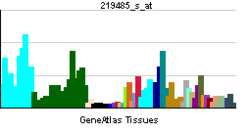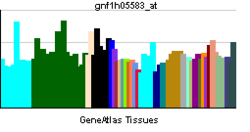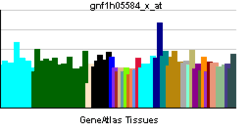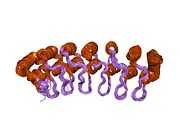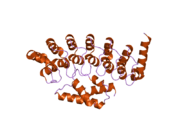PSMD10
26S proteasome non-ATPase regulatory subunit 10 is an enzyme that in humans is encoded by the PSMD10 gene.[1]
Function
The 26S proteasome is a multicatalytic proteinase complex with a highly ordered structure composed of 2 complexes, a 20S core and a 19S regulator. The 20S core is composed of 4 rings of 28 non-identical subunits; 2 rings are composed of 7 alpha subunits and 2 rings are composed of 7 beta subunits. The 19S regulator is composed of a base, which contains 6 ATPase subunits and 2 non-ATPase subunits, and a lid, which contains up to 10 non-ATPase subunits. Proteasomes are distributed throughout eukaryotic cells at a high concentration and cleave peptides in an ATP/ubiquitin-dependent process in a non-lysosomal pathway. An essential function of a modified proteasome, the immunoproteasome, is the processing of class I MHC peptides. This gene encodes a non-ATPase subunit of the 19S regulator. Two transcripts encoding different isoforms have been described. Pseudogenes have been identified on chromosomes 3 and 20.[2]
Interactions
PSMD10 has been shown to interact with:
References
- ↑ Hori T, Kato S, Saeki M, DeMartino GN, Slaughter CA, Takeuchi J et al. (Oct 1998). "cDNA cloning and functional analysis of p28 (Nas6p) and p40.5 (Nas7p), two novel regulatory subunits of the 26S proteasome". Gene 216 (1): 113–22. doi:10.1016/S0378-1119(98)00309-6. PMID 9714768.
- ↑ "Entrez Gene: PSMD10 proteasome (prosome, macropain) 26S subunit, non-ATPase, 10".
- ↑ Qiu W, Wu J, Walsh EM, Zhang Y, Chen CY, Fujita J et al. (Jul 2008). "Retinoblastoma protein modulates gankyrin-MDM2 in regulation of p53 stability and chemosensitivity in cancer cells". Oncogene 27 (29): 4034–43. doi:10.1038/onc.2008.43. PMID 18332869.
- ↑ 4.0 4.1 Ewing RM, Chu P, Elisma F, Li H, Taylor P, Climie S et al. "Large-scale mapping of human protein-protein interactions by mass spectrometry". Mol. Syst. Biol. 3: 89. doi:10.1038/msb4100134. PMC 1847948. PMID 17353931.
- ↑ Rual JF, Venkatesan K, Hao T, Hirozane-Kishikawa T, Dricot A, Li N et al. (Oct 2005). "Towards a proteome-scale map of the human protein-protein interaction network". Nature 437 (7062): 1173–8. doi:10.1038/nature04209. PMID 16189514.
- ↑ Dawson S, Apcher S, Mee M, Higashitsuji H, Baker R, Uhle S et al. (Mar 2002). "Gankyrin is an ankyrin-repeat oncoprotein that interacts with CDK4 kinase and the S6 ATPase of the 26 S proteasome". J. Biol. Chem. 277 (13): 10893–902. doi:10.1074/jbc.M107313200. PMID 11779854.
Further reading
- Coux O, Tanaka K, Goldberg AL (1996). "Structure and functions of the 20S and 26S proteasomes.". Annu. Rev. Biochem. 65: 801–47. doi:10.1146/annurev.bi.65.070196.004101. PMID 8811196.
- Goff SP (2003). "Death by deamination: a novel host restriction system for HIV-1.". Cell 114 (3): 281–3. doi:10.1016/S0092-8674(03)00602-0. PMID 12914693.
- Sastry L, Cao T, King CR (1997). "Multiple Grb2-protein complexes in human cancer cells.". Int. J. Cancer 70 (2): 208–13. doi:10.1002/(SICI)1097-0215(19970117)70:2<208::AID-IJC12>3.0.CO;2-E. PMID 9009162.
- Seeger M, Ferrell K, Frank R, Dubiel W (1997). "HIV-1 tat inhibits the 20 S proteasome and its 11 S regulator-mediated activation.". J. Biol. Chem. 272 (13): 8145–8. doi:10.1074/jbc.272.13.8145. PMID 9079628.
- Madani N, Kabat D (1998). "An endogenous inhibitor of human immunodeficiency virus in human lymphocytes is overcome by the viral Vif protein.". J. Virol. 72 (12): 10251–5. PMC 110608. PMID 9811770.
- Simon JH, Gaddis NC, Fouchier RA, Malim MH (1998). "Evidence for a newly discovered cellular anti-HIV-1 phenotype.". Nat. Med. 4 (12): 1397–400. doi:10.1038/3987. PMID 9846577.
- Mulder LC, Muesing MA (2000). "Degradation of HIV-1 integrase by the N-end rule pathway.". J. Biol. Chem. 275 (38): 29749–53. doi:10.1074/jbc.M004670200. PMID 10893419.
- Dawson S, Apcher S, Mee M, Higashitsuji H, Baker R, Uhle S et al. (2002). "Gankyrin is an ankyrin-repeat oncoprotein that interacts with CDK4 kinase and the S6 ATPase of the 26 S proteasome.". J. Biol. Chem. 277 (13): 10893–902. doi:10.1074/jbc.M107313200. PMID 11779854.
- Sheehy AM, Gaddis NC, Choi JD, Malim MH (2002). "Isolation of a human gene that inhibits HIV-1 infection and is suppressed by the viral Vif protein.". Nature 418 (6898): 646–50. doi:10.1038/nature00939. PMID 12167863.
- Fu XY, Wang HY, Tan L, Liu SQ, Cao HF, Wu MC (2002). "Overexpression of p28/gankyrin in human hepatocellular carcinoma and its clinical significance.". World J. Gastroenterol. 8 (4): 638–43. PMID 12174370.
- Huang X, Seifert U, Salzmann U, Henklein P, Preissner R, Henke W et al. (2002). "The RTP site shared by the HIV-1 Tat protein and the 11S regulator subunit alpha is crucial for their effects on proteasome function including antigen processing.". J. Mol. Biol. 323 (4): 771–82. doi:10.1016/S0022-2836(02)00998-1. PMID 12419264.
- Nagao T, Higashitsuji H, Nonoguchi K, Sakurai T, Dawson S, Mayer RJ et al. (2003). "MAGE-A4 interacts with the liver oncoprotein gankyrin and suppresses its tumorigenic activity.". J. Biol. Chem. 278 (12): 10668–74. doi:10.1074/jbc.M206104200. PMID 12525503.
- Gaddis NC, Chertova E, Sheehy AM, Henderson LE, Malim MH (2003). "Comprehensive investigation of the molecular defect in vif-deficient human immunodeficiency virus type 1 virions.". J. Virol. 77 (10): 5810–20. doi:10.1128/JVI.77.10.5810-5820.2003. PMC 154025. PMID 12719574.
- Lecossier D, Bouchonnet F, Clavel F, Hance AJ (2003). "Hypermutation of HIV-1 DNA in the absence of the Vif protein.". Science 300 (5622): 1112. doi:10.1126/science.1083338. PMID 12750511.
- Zhang H, Yang B, Pomerantz RJ, Zhang C, Arunachalam SC, Gao L (2003). "The cytidine deaminase CEM15 induces hypermutation in newly synthesized HIV-1 DNA.". Nature 424 (6944): 94–8. doi:10.1038/nature01707. PMC 1350966. PMID 12808465.
- Mangeat B, Turelli P, Caron G, Friedli M, Perrin L, Trono D (2003). "Broad antiretroviral defence by human APOBEC3G through lethal editing of nascent reverse transcripts.". Nature 424 (6944): 99–103. doi:10.1038/nature01709. PMID 12808466.
- Harris RS, Bishop KN, Sheehy AM, Craig HM, Petersen-Mahrt SK, Watt IN et al. (2003). "DNA deamination mediates innate immunity to retroviral infection.". Cell 113 (6): 803–9. doi:10.1016/S0092-8674(03)00423-9. PMID 12809610.
| |||||||||||||||

